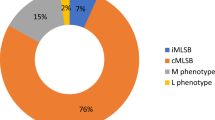Abstract
Abstract
The frequency of resistance to erythromycin of group A beta-haemolytic streptococci in the last 7 years was determined in three medical centres in Ankara. While all group A beta-haemolytic streptococci strains were susceptible to penicillin, a gradual increase in resistance to erythromycin until 1992 was observed. However, a substantial increase in erythromycin resistance occurred in 1993 when newer macrolides became available and were widely used in the latter part of 1992.
Conclusion
The data show that frequent testing for resistance to erythromycin of group A betahaemolytic streptococci is required for the use of this antibiotic in our country.
Similar content being viewed by others
Abbreviations
- GABHS :
-
group A beta-haemolytic streptococci
References
Arthur JD, Keiser JF, Higbee J (1984) Erythromycin-resistant group A beta-hemolytic streptococci: prevalence at four medical centers. Pediatr Infect Dis J 3:489
Ayoub EM (1992) Resurgence of rheumatic fever in the United States. Postgrad Med 92:133–136
Bass JW, Weisse ME, Plymyer MR, Murphy S, Eberly BJ (1994) Decline of erythromycin resistance of group A beta-hemolytic streptococci in Japan. Arch Pediatr Adolesc Med 148:67–71
Bauer AW, Kirby WMM, Sherris JC, Turck M (1966) Antibiotic susceptibility testing by a standardized single disc method. Am J Clin Pathol 45:493–496
Berkiten R, Aĝaçfidan A, Mustafa M (1989) Beta-hemolytic streptococci isolated from throat swabs and their antibiotic susceptibilities. ANKEM Derg 3:564–567
Betriu C, Sanchez A, Gomez M, Cruceyra A, Picazo JJ (1993) Antibiotic susceptibility of group A streptococci: a 6-year follow-up study. Antimicrob Agents Chemother 37:1717–1719
Bisno AL (1991) Group A streptococcal infections and acute rheumatic fever. N Engl J Med 325:783–793
Durmaz B, Durmaz R (1992) Grouping of beta-hemolytic streptococci isolated from throat swabs and investigation of their susceptibility. ANKEM Derg 6: 25–28
Grayston JT, Kuo C-C, Wang SP, Altman J (1986) A newChlamydia psittaci strain, TWAR, isolated in acute respiratory tract infections. N Engl J Med 315:161–168
Grayston JT, Campbell LA, Kuo C-C, Mordhorst CH, Saikku P, Thom DH, Wang S-P (1990) A new respiratory tract pathogen:Chlamydia pneumonia strain TWAR. J Infect Dis 161:618–625
Huovinen P, Lahtonen R, Ziegler T (1989) Pharyngitis in adults: the presence and coexistence of viruses and bacterial organisms. Am Intern Med 110:612–616
Istre GR, Welch DF, Marks MI, Moyer N (1981) Susceptibility of group A beta-hemolytic streptococcus isolates to penicillin and erythromycin. Antimicrob Agents Chemother 20:244–246
Kallings I, Bengtsson S, Christensen P, Holm SE, Lind L, Kalin M (1983) Antibiotic sensitivity ofHaemophilus influenza, Streptococcus pneumonia, Streptococcus pyogenes andBranhamella catarrhalis isolated from upper respiratory tract infections in Sweden. Scand J Infect Dis [Suppl] 39: 100–105
Kaplan EL (1991) The resurgence of group A streptococcal infections and their sequelae. Eur J Clin Microbiol Infect Dis 10:55–57
Kelley R, Langley G, Bates L (1993) Erythromycin: still a good choice for strep throat. Clin Pediatr 8:744–745
Kiraz N, Ak§it F, Kocaoĝlu T (1990) The results of antibiotic susceptibilities in group A beta-hemolytic streptococci isolated from throat swabs. Mikrobiyol Bült 24:237–241
Martin RR, Hoiby EA (1990) Streptococcal serogroup A epidemic in Norway 1987–1988. Scand J Infect Dis 22: 421–429
Mitsuhashi S, Inoue M, Saito K, Nakae M (1982) Drug resistance inStreptococcus pyogenes strains isolated in Japan. In: Schlessinger D (ed) Microbiology. American Society for Microbiology, Washington, DC, pp 151–154
National Committee for Clinical Laboratory Standards (1992) Performance standards for antimicrobial disk susceptibility test. M100-S3; M2-A4. NC-CLS 10 (7)
Philips G, Parrat D, Orange GV, Harper I, Mc Ewan H, Young N (1990) Erythromycin-resistantStreptococcus pyogenes. J Antimicrob Chemother 25: 723–724
Picard E, Gedalia A, Benmeir P, Zucker N, Barki Y (1992) Abdominal pain with free peritoneal fluid detected by ultrasonoghraphy as a presenting manifestation of acute rheumatic fever. Ann Rheum Dis 51:394–395
Rathore MH, Jenkins SG (1992) Group A beta-hemolytic streptococcus: issues of resistance. Pediatr Infect Dis J 12: 354–355
Rathore MH, Barton LL, Kaplan EL (1992) Suppurative group A beta-hemolytic streptococcal infections in children. Pediatrics 89:743–746
Seppala H, Nissinen A, Järvinen H, Huovinen S, Henriksson T, Herva E, Holm SE, Jahkola M, Katyla ML, Klaukka T, Kontiainen S, Liimatainen O, Oinonen S, Passi-Metsomaa L, Huovinen P (1992) Resistance to erythromycin in group A streptococci. N Engl J Med 326:292–297
Spencer RC, Wheat PF, Magee JT, Brown EH (1989) Erythromycin resistance in streptococci. Lancet I:168
Stingemore N, Francis GR, Toohey M, Mc Gechie DB (1989) The emergence of erythromycin resistance inStreptococcus pyogenes in Fremantle, Western Australia. Med J Aust 150:626–631
Stollerman GH (1988) Changing group A streptococci: the reappearance of streptococcal “toxic-shock”. Arch Intern Med 148:1268–1270
Türet G, Karabiber N (1990) Penicillin G and erythromycin susceptibility of group A beta-hemolytic streptococci. ANKEM Derg 4:479–483
Washington JA (1985) Erythromycin: a microbial and clinical perspective after 30 years of clinical use. Mayo Clin Proc 40:189–203
Wittler RR, Yamada SM, Bass JW, Hamill R, Wiebe RA, Ascher DP (1992) Penicillin tolerance and erythromycin resistance of group A beta-hemolytic streptococci in Hawaii and the Philippines. Am J Dis Child 144: 587–589
Zackrisson G, Lind L, Roos K, Larsson P (1988) Erythromycin resistant beta-hemolytic streptococci group A in Göteborg, Sweden. J Infect Dis 20: 419–420
Author information
Authors and Affiliations
Rights and permissions
About this article
Cite this article
Kürekçi, A.F., Baysallar, M., Karaarslan, A. et al. The frequency of resistance to erythromycin in group A streptococci in Ankara. Eur J Pediatr 155, 780–782 (1996). https://doi.org/10.1007/BF02002906
Received:
Accepted:
Issue Date:
DOI: https://doi.org/10.1007/BF02002906




